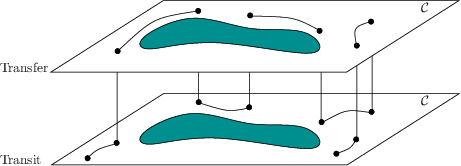
Next: Manipulation graph Up: 7.3.2 Manipulation Planning Previous: Admissible configurations
Two important subsets of
![]() are used in the manipulation planning
problem. See Figure 7.15. Let
are used in the manipulation planning
problem. See Figure 7.15. Let
![]() denote the set
of stable part configurations, which are configurations at which
the part can safely rest without any forces being applied by the
manipulator. This means that a part cannot, for example, float in the
air. It also cannot be in a configuration from which it might fall.
The particular stable configurations depend on properties such as the
part geometry, friction, mass distribution, and so on. These issues
are not considered here. From this, let
denote the set
of stable part configurations, which are configurations at which
the part can safely rest without any forces being applied by the
manipulator. This means that a part cannot, for example, float in the
air. It also cannot be in a configuration from which it might fall.
The particular stable configurations depend on properties such as the
part geometry, friction, mass distribution, and so on. These issues
are not considered here. From this, let
![]() be
the corresponding stable configurations, defined as
be
the corresponding stable configurations, defined as
| (7.19) |
We must always ensure that either
![]() or
or
![]() .
Therefore, let
.
Therefore, let
![]() , to reflect the subset of
, to reflect the subset of
![]() that is permissible for manipulation planning.
that is permissible for manipulation planning.
The mode space, ![]() , contains two modes, which are named the transit mode and the transfer mode. In the transit mode, the
manipulator is not carrying the part, which requires that
, contains two modes, which are named the transit mode and the transfer mode. In the transit mode, the
manipulator is not carrying the part, which requires that
![]() . In the transfer mode, the manipulator carries the part, which
requires that
. In the transfer mode, the manipulator carries the part, which
requires that
![]() . Based on these simple conditions, the
only way the mode can change is if
. Based on these simple conditions, the
only way the mode can change is if
![]() .
Therefore, the manipulator has two available actions only when it is
in these configurations. In all other configurations the mode remains
unchanged. For convenience, let
.
Therefore, the manipulator has two available actions only when it is
in these configurations. In all other configurations the mode remains
unchanged. For convenience, let
![]() denote the
set of transition configurations, which are the places in which the mode may change.
denote the
set of transition configurations, which are the places in which the mode may change.
Using the framework of Section 7.3.1, the mode space,
![]() , and C-space,
, and C-space, ![]() , are combined to yield the state space,
, are combined to yield the state space,
![]() . Since there are only two modes,
there are only two copies of
. Since there are only two modes,
there are only two copies of ![]() , one for each mode. State-based
sets,
, one for each mode. State-based
sets,
![]() ,
, ![]() ,
, ![]() , and
, and ![]() , are directly obtained
from
, are directly obtained
from
![]() ,
,
![]() ,
,
![]() , and
, and
![]() by ignoring the mode. For
example,
by ignoring the mode. For
example,
| (7.20) |
The task can now be defined. An initial part configuration,
![]() , and a goal part configuration,
, and a goal part configuration,
![]() , are specified. Compute a path
, are specified. Compute a path
![]() such that
such that
![]() and
and
![]() .
Furthermore, the action trajectory
.
Furthermore, the action trajectory
![]() must be specified to indicate the appropriate mode changes whenever
must be specified to indicate the appropriate mode changes whenever
![]() . A solution can be considered as an alternating
sequence of transit paths and transfer
paths, whose names follow from the mode. This
is depicted in Figure 7.16.
. A solution can be considered as an alternating
sequence of transit paths and transfer
paths, whose names follow from the mode. This
is depicted in Figure 7.16.
 |
Steven M LaValle 2020-08-14